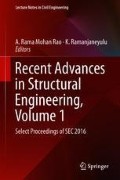Abstract
The tremendous housing need of India is causing the depletion of virgin building materials. In an era of scarce resources, sustainable solutions are always preferable. Glass Fibre Reinforced Gypsum (GFRG) technology is one such solution where all the structural members are constructed using hollow panels infilled with reinforced concrete (RC), as per structural design. This paper discusses the sustainability of construction using GFRG panels in terms of embodied energy and indoor thermal comfort. The case study building at IIT Madras campus was found to have lesser embodied energy compared to conventional buildings. The result is significant considering the fact that the building sector consumes 40% of the total energy in world. Also, the inside temperature was found to be lesser by 2 °C which will help in reducing the air conditioning requirement of the building and thereby the operational energy.
Access this chapter
Tax calculation will be finalised at checkout
Purchases are for personal use only
References
Monteiro, A. (2015) Assessing initial embodied energy in building structures using LCA methodology (MS thesis). New University of Lisbon, Portugal.
Structural Engineering Division, IITM. (2016). GFRG Construction manual, BMTPC, MHUPA.
Omahen, R. (2002). Ecologically sustainable development: Approaches in the construction industry (Thesis). University of Regensburg, Germany.
Reddy, B. V. V., & Jagadish, K. S. (2003). Embodied energy of common and alternative building materials and technologies. Energy and Buildings, 35, 129–137.
Shukla, A., Tiwari, G. N., & Sodha, M. S. (2009). Embodied energy analysis of adobe house. Renewable Energy, 34, 755–761.
Chani, P. S., & Najamuddin, K. S. K. (2003). Comparative analysis of embodied energy rates for walling elements in India. Institution of Engineers (India) Journal-Architecture, 84, 47–50.
Hammond, G., & Jones C. (2008). Inventory of carbon and energy (ICE), Version 1.6a. UK: University of BATH.
Pinky, D. L., & Palaniappan, S. (2014). A case study on life cycle energy use of residential building in southern India. Energy and Buildings, 80, 247–259.
Acknowledgements
The authors are thankful to the Engineering Unit of IIT Madras for their support. The funding for the construction of the demo building by IIT Madras and Department of Science and Technology is gratefully acknowledged.
Author information
Authors and Affiliations
Corresponding author
Editor information
Editors and Affiliations
Rights and permissions
Copyright information
© 2019 Springer Nature Singapore Pte Ltd.
About this paper
Cite this paper
Gouri Krishna, S.R., Cherian, P., Menon, D., Prasad, A.M. (2019). Glass Fibre Reinforced Gypsum Panels for Sustainable Construction. In: Rao, A., Ramanjaneyulu, K. (eds) Recent Advances in Structural Engineering, Volume 1. Lecture Notes in Civil Engineering , vol 11. Springer, Singapore. https://doi.org/10.1007/978-981-13-0362-3_69
Download citation
DOI: https://doi.org/10.1007/978-981-13-0362-3_69
Published:
Publisher Name: Springer, Singapore
Print ISBN: 978-981-13-0361-6
Online ISBN: 978-981-13-0362-3
eBook Packages: EngineeringEngineering (R0)

